BiVO4–Deposited MIL–101–NH2 for Efficient Photocatalytic Elimination of Cr(VI)
Abstract
:1. Introduction
2. Results and Discussion
2.1. Materials Characterization
2.2. Photocatalytic Behaviours on Cr(VI) Reduction
2.3. Mechanism on the Photocatalytic Efficiency Promotion
3. Experimental
3.1. Material
3.2. Synthesis of MIL–101–NH2/BiVO4 Composite
3.3. Characterization
3.4. Photocatalytic Reduction of Cr(VI)
4. Conclusions
Supplementary Materials
Author Contributions
Funding
Institutional Review Board Statement
Informed Consent Statement
Data Availability Statement
Conflicts of Interest
References
- Ma, H.; Yang, Y.; Yin, F.; Zhang, X.F.; Qiu, J.; Yao, J. Integration of thermoresponsive MIL-121 into alginate beads for efficient heavy metal ion removal. J. Clean. Prod. 2022, 333, 130229. [Google Scholar] [CrossRef]
- Barrera-Diaz, C.E.; Lugo-Lugo, V.; Bilyeu, B. A review of chemical, electrochemical and biological methods for aqueous Cr(VI) reduction. J. Hazard. Mater. 2012, 223–224, 1–12. [Google Scholar] [CrossRef]
- Karimi-Maleh, H.; Ayati, A.; Ghanbari, S.; Orooji, Y.; Tanhaei, B.; Karimi, F.; Alizadeh, M.; Rouhi, J.; Fu, L.; Sillanpää, M. Recent advances in removal techniques of Cr(VI) toxic ion from aqueous solution: A comprehensive review. J. Mol. Liq. 2021, 329, 115062. [Google Scholar] [CrossRef]
- Pelaez, M.; Nolan, N.T.; Pillai, S.C.; Seery, M.K.; Falaras, P.; Kontos, A.G.; Dunlop, P.S.; Hamilton, J.W.; Byrne, J.A.; O’shea, K. A review on the visible light active titanium dioxide photocatalysts for environmental applications. Appl. Catal. B 2012, 125, 331–349. [Google Scholar] [CrossRef] [Green Version]
- Chandel, M.; Thakur, M.; Sharma, A.; Pathania, D.; Kumar, A.; Singh, L. Chlorophyll sensitized (BiO)2CO3/ CdWO4/rGO nano-hybrid assembly for solar assisted photo-degradation of chlorzoxazone. Chemosphere 2022, 305, 135472. [Google Scholar] [CrossRef] [PubMed]
- Kumar, A.; Sharma, K.; Thakur, M.; Pathania, D.; Sharma, A. Fabrication of high visible light active LaFeO3/Cl-g-C3N4/RGO heterojunction for solar assisted photo-degradation of aceclofenac. J. Environ. Chem. Eng. 2022, 10, 108098. [Google Scholar] [CrossRef]
- Kumar, A.; Pathania, D.; Gupta, N.; Raj, P.; Sharma, A. Photo-degradation of noxious pollutants from water system using Cornulaca monacantha stem supported ZnFe2O4 magnetic bio-nanocomposite. Sustain. Chem. 2020, 18, 100290. [Google Scholar] [CrossRef]
- Rather, R.A.; Mehta, A.; Lu, Y.; Valant, M.; Fang, M.; Liu, W. Influence of exposed facets, morphology and hetero-interfaces of BiVO4 on photocatalytic water oxidation: A review. Int. J. Hydrogen Energy 2021, 46, 21866–21888. [Google Scholar] [CrossRef]
- Obregón, S.; Caballero, A.; Colón, G. Hydrothermal synthesis of BiVO4: Structural and morphological influence on the photocatalytic activity. Appl. Catal. B 2012, 117-118, 59–66. [Google Scholar] [CrossRef]
- Lai, H.F.; Chen, C.C.; Chang, Y.K.; Lu, C.S.; Wu, R.J. Efficient photocatalytic degradation of thiobencarb over BiVO4 driven by visible light: Parameter and reaction pathway investigations. Sep. Purif. Technol. 2014, 122, 78–86. [Google Scholar] [CrossRef]
- Ying, Y.Q.; Tao, F.F.; Hong, T.J.; Wang, L.X. Controlled fabrication of bismuth vanadium oxide hierarchical microtubes with enhanced visible light photocatalytic activity. Mater. Sci. Semicond. Process. 2015, 32, 82–89. [Google Scholar] [CrossRef]
- Liu, S.Q.; Tang, H.L.; Zhou, H.; Dai, G.P.; Wang, W.Q. Photocatalytic perfermance of sandwich-like BiVO4 sheets by microwave assisted synthesis. Appl. Surf. Sci. 2017, 391, 542–547. [Google Scholar] [CrossRef]
- Jiao, L.; Wang, Y.; Jiang, H.L.; Xu, Q. Metal–Organic Frameworks as Platforms for Catalytic Applications. Adv. Mater. 2018, 30, 1703663. [Google Scholar] [CrossRef]
- Zhu, X.; Fan, Z.; Zhang, X.F.; Yao, J. Metal-organic frameworks decorated wood aerogels for efficient particulate matter removal. J. Colloid Interface Sci. 2023, 629, 182–188. [Google Scholar] [CrossRef]
- Hu, Z.; Zhang, H.; Zhang, X.F.; Jia, M.; Yao, J. Polyethylenimine grafted ZIF-8@cellulose acetate membrane for enhanced gas separation. J. Membr. Sci. 2022, 662, 120996. [Google Scholar] [CrossRef]
- Zhang, X.F.; Wang, Z.; Ding, M.; Feng, Y.; Yao, J. Advances in cellulose-metal organic framework composites: Preparation and applications. J. Mater. Chem. A 2021, 9, 23353–23363. [Google Scholar] [CrossRef]
- Liu, J.; Hao, D.D.; Sun, H.W.; Li, Y.; Han, J.L.; Fu, B.; Zhou, J.C. Integration of MIL-101-NH2 into Cellulosic Foams for Efficient Cr(VI) Reduction under Visible Light. Ind. Eng. Chem. Res. 2021, 60, 12220–12227. [Google Scholar] [CrossRef]
- Wang, Q.; Gao, Q.; Al-Enizi, A.M.; Nafady, A.; Ma, S. Recent advances in MOF-based photocatalysis: Environmental remediation under visible light. Inorg. Chem. Front. 2020, 7, 300–339. [Google Scholar] [CrossRef]
- Huang, C.; Wang, J.; Li, M.; Lei, X.; Wu, Q. Construction of a novel Z-scheme V2O5/NH2-MIL-101(Fe) composite photocatalyst with enhanced photocatalytic degradation of tetracycline. Solid State Sci. 2021, 117, 106611. [Google Scholar] [CrossRef]
- Gao, D.W.; Wang, Z.L.; Wang, C.; Wang, L.Y.; Chi, Y.; Wang, M.G.; Zhang, J.J.; Wu, C.; Gu, Y.; Wang, H.L.; et al. CrPd nanoparticles on NH2-functionalized metal-organic framework as a synergistic catalyst for efficient hydrogen evolution from formic acid. Chem. Eng. J. 2019, 361, 953–959. [Google Scholar] [CrossRef]
- Malathi, A.; Madhavan, J.; Ashokkumar, M.; Arunachalam, P. A review on BiVO4 photocatalyst: Activity enhancement methods for solar photocatalytic applications. Appl. Catal. A 2018, 555, 47–74. [Google Scholar] [CrossRef]
- Yuan, Q.; Chen, L.; Xiong, M.; He, J.; Luo, S.L.; Au, C.T.; Yin, S.F. Cu2O/BiVO4 heterostructures: Synthesis and application in simultaneous photocatalytic oxidation of organic dyes and reduction of Cr(VI) under visible light. Chem. Eng. J. 2014, 255, 394–402. [Google Scholar] [CrossRef]
- Sun, Y.; Wang, H.; Xing, Q.; Cui, W.; Li, J.; Wu, S.; Sun, L. The pivotal effects of oxygen vacancy on Bi2MoO6: Promoted visible light photocatalytic activity and reaction mechanism. Chin. J. Catal. 2019, 40, 647–655. [Google Scholar] [CrossRef]
- Hou, Y.; Wen, Z.; Cui, S.; Guo, X.; Chen, J. Constructing 2D Porous Graphitic C3N4 Nanosheets/Nitrogen-Doped Graphene/Layered MoS2 Ternary Nanojunction with Enhanced Photoelectrochemical Activity. Adv. Mater. 2013, 25, 6291–6297. [Google Scholar] [CrossRef] [PubMed]
- Qiu, J.H.; Li, M.; Yang, Y.; Yao, J.F. Facile construction of three-dimensional netted ZnIn2S4 by cellulose nanofibrils for efficiently photocatalytic reduction of Cr(VI). Chem. Eng. J. 2019, 375, 121990. [Google Scholar] [CrossRef]
- Zhao, W.; Feng, Y.; Huang, H.B.; Zhou, P.C.; Li, J.; Zhang, L.L.; Dai, B.L.; Xu, J.M.; Zhu, F.X.; Sheng, N.; et al. A novel Z-scheme Ag3VO4/BiVO4 heterojunction photocatalyst: Study on the excellent photocatalytic performance and photocatalytic mechanism. Appl. Catal. B 2019, 245, 448–458. [Google Scholar] [CrossRef]
- Park, J.M.; Jhung, S.H. A remarkable adsorbent for removal of bisphenol S from water: Aminated metal-organic framework, MIL-101-NH2. Chem. Eng. J. 2020, 396, 125224. [Google Scholar] [CrossRef]
- Nguyen, V.H.; Bui, Q.T.P.; Vo, D.N.; Lim, K.T.; Bach, L.G.; Do, S.T.; Nguyen, T.V.; Doan, V.D.; Nguyen, T.D.; Nguyen, T.D. Effective Photocatalytic Activity of Sulfate-Modified BiVO4 for the Decomposition of Methylene Blue under LED Visible Light. Materials 2019, 12, 2681. [Google Scholar] [CrossRef] [Green Version]
- Zhu, L.; Zong, L.; Wu, X.; Li, M.; Wang, H.; You, J.; Li, C. Shapeable Fibrous Aerogels of Metal–Organic-Frameworks Templated with Nanocellulose for Rapid and Large-Capacity Adsorption. ACS Nano 2018, 12, 4462–4468. [Google Scholar] [CrossRef]
- Fu, B.; Sun, H.; Liu, J.; Zhou, T.; Chen, M.; Cai, Z.; Hao, D.; Zhu, X. Construction of MIL-125-NH2@BiVO4 Composites for Efficient Photocatalytic Dye Degradation. ACS Omega 2022, 7, 26201–26210. [Google Scholar] [CrossRef]
- Ferreira, E.H.M.; Moutinho, M.V.O.; Stavale, F.; Lucchese, M.M.; Capaz, R.B.; Achete, C.A.; Jorio, A. Evolution of the Raman spectra from single-, few-, and many-layer graphene with increasing disorder. Phys. Rev. B 2010, 82, 125429. [Google Scholar] [CrossRef] [Green Version]
- Ferrari, A.C.; Robertson, J. Interpretation of Raman spectra of disordered and amorphous carbon. Phys. Rev. B 2000, 61, 14095. [Google Scholar] [CrossRef] [Green Version]
- Kekade, S.S.; Gaikwad, P.V.; Raut, S.A.; Choudhary, R.J.; Mathe, V.L.; Phase, D.; Kshirsagar, A.; Patil, S.I. Electronic Structure of Visible Light-Driven Photocatalyst δ-Bi11VO19 Nanoparticles Synthesized by Thermal Plasma. ACS Omega 2018, 3, 5853–5864. [Google Scholar] [CrossRef] [PubMed]
- Qiang, T.; Chen, L.; Xia, Y.; Qin, X. Dual modified MoS2/SnS2 photocatalyst with Z-scheme heterojunction and vacancies defects to achieve a superior performance in Cr (VI) reduction and dyes degradation. J. Clean. Prod. 2021, 291, 125213. [Google Scholar] [CrossRef]
- Ning, X.; Zhen, W.; Wu, Y.; Lu, G. Inhibition of CdS photocorrosion by Al2O3 shell for highly stable photocatalytic overall water splitting under visible light irradiation. Appl. Catal. B 2018, 226, 373–383. [Google Scholar] [CrossRef]
- Xu, Y.; Lv, M.; Yang, H.; Chen, Q.; Liu, X.; Fengyu, W. BiVO4/MIL-101 composite having the synergistically enhanced visible light photocatalytic activity. RSC Adv. 2015, 5, 43473–43479. [Google Scholar] [CrossRef]
- Li, Y.; Zhang, H.; Rashid, A.; Hu, A.; Xin, K.; Li, H.; Adyari, B.; Wang, Y.; Yu, C.-P.; Sun, Q. Bisphenol A attenuation in natural microcosm: Contribution of ecological components and identification of transformation pathways through stable isotope tracing. J. Hazard. Mater. 2020, 385, 121584. [Google Scholar] [CrossRef] [PubMed]
- Jian, C.; David, F.O.; Wim, H.R.; Harry, B. Kinetic processes of photocatalytic mineralization of alcohols on metallized titanium dioxide. Water Res. 1999, 33, 1173–1180. [Google Scholar] [CrossRef]
- Arslan, H.; Eskikaya, O.; Bilici, Z.; Dizge, N.; Balakrishnan, D. Comparison of Cr(VI) adsorption and photocatalytic reduction efficiency using leonardite powder. Chemosphere 2022, 300, 134492. [Google Scholar] [CrossRef]
- Wang, N.; Zhu, L.; Deng, K.; She, Y.; Yu, Y.; Tang, H. Visible light photocatalytic reduction of Cr(VI) on TiO2 in situ modified with small molecular weight organic acids. Appl. Catal. B 2010, 95, 400–407. [Google Scholar] [CrossRef]
- Yang, F.; Guo, Y.; Li, C.; Tang, D.; Jiang, H.; Wang, G.; Xuan, K. Facile fabrication of AgFe1−xCuxO2 composite with abundant oxygen vacancies for boosted photocatalytic Cr (VI) reduction and organic pollutants degradation under visible light. Colloids Surf. Physicochem. Eng. Asp. 2021, 628, 127305. [Google Scholar] [CrossRef]
- Ding, J.; Chen, M.Q.; Du, X.W.; Shang, R.L.; Xia, M.Y.; Hu, J.M.; Zhong, Q. Visible-Light-Driven Photoreduction of CO2 to CH4 with H2O Over Amine-Functionalized MIL-125(Ti). Catal. Lett. 2019, 149, 3287–3295. [Google Scholar] [CrossRef]
- Su, S.; Xing, Z.; Zhang, S.; Du, M.; Wang, Y.; Li, Z.; Chen, P.; Zhu, Q.; Zhou, W. Ultrathin mesoporous g-C3N4/NH2-MIL-101(Fe) octahedron heterojunctions as efficient photo-Fenton-like system for enhanced photo-thermal effect and promoted visible-light-driven photocatalytic performance. Appl. Surf. Sci. 2021, 537, 147890. [Google Scholar] [CrossRef]
- Hassan, J.Z.; Raza, A.; Qumar, U.; Li, G. Recent advances in engineering strategies of Bi-based photocatalysts for environmental remediation. Sustain. Mater. Technol. 2022, 33, e00478. [Google Scholar] [CrossRef]
- Hu, X.; Wang, W.; Xie, G.; Wang, H.; Tan, X.; Jin, Q.; Zhou, D.; Zhao, Y. Ternary assembly of g-C3N4/graphene oxide sheets/BiFeO3 heterojunction with enhanced photoreduction of Cr(VI) under visible-light irradiation. Chemosphere 2019, 216, 733–741. [Google Scholar] [CrossRef] [PubMed]
- Li, H.; Zhao, C.; Li, X.; Fu, H.F.; Wang, Z.H.; Wang, C.C. Boosted photocatalytic Cr(VI) reduction over Z-scheme MIL-53(Fe)/Bi12O17Cl2 composites under white light. J. Alloys Compd. 2020, 844, 156147. [Google Scholar] [CrossRef]
- Guo, T.; Yang, S.; Chen, Y.; Yang, L.; Sun, Y.; Shang, Q. Photocatalytic kinetics and cyclic stability of photocatalysts Fe-complex/TiO2 in the synergistic degradation of phenolic pollutants and reduction of Cr(VI). Environ. Sci. Pollut. Res. Int. 2021, 28, 12459–12473. [Google Scholar] [CrossRef]
- Yi, X.H.; Wang, F.X.; Du, X.D.; Wang, P.; Wang, C.C. Facile fabrication of BUC-21/g-C3N4 composites and their enhanced photocatalytic Cr(VI) reduction performances under simulated sunlight. Appl. Organomet. Chem. 2019, 33, e4621. [Google Scholar] [CrossRef] [Green Version]
- Lei, D.S.; Xue, J.Q.; Bi, Q.; Tang, C.B.; Zhang, L. 3D/2D direct Z -scheme photocatalyst Zn2SnO4/CdS for simultaneous removal of Cr(VI) and organic pollutant. Appl. Surf. Sci. 2020, 517, 146030. [Google Scholar] [CrossRef]
- Sun, Y.; Han, L.; Strasser, P. A comparative perspective of electrochemical and photochemical approaches for catalytic H2O2 production. Chem. Soc. Rev. 2020, 49, 6605–6631. [Google Scholar] [CrossRef]
- Torres-Pinto, A.; Sampaio, M.J.; Silva, C.G.; Faria, J.L.; Silva, A.M.T. Recent Strategies for Hydrogen Peroxide Production by Metal-Free Carbon Nitride Photocatalysts. Catalysts 2019, 9, 990. [Google Scholar] [CrossRef] [Green Version]
- Shi, H.; Li, C.; Wang, L.; Wang, W.; Meng, X. Selective reduction of nitrate into N2 by novel Z-scheme NH2-MIL-101(Fe)/BiVO4 heterojunction with enhanced photocatalytic activity. J. Hazard. Mater. 2022, 424, 127711. [Google Scholar] [CrossRef] [PubMed]
- Bauer, S.; Serre, C.; Devic, T.; Horcajada, P.; Marrot, J.; Férey, G.; Stock, N. High-Throughput Assisted Rationalization of the Formation of Metal Organic Frameworks in the Iron(III) Aminoterephthalate Solvothermal System. Inorg. Chem. 2008, 47, 7568–7576. [Google Scholar] [CrossRef] [PubMed]
- Foulady-Dehaghi, R.; Sohrabnezhad, S. Hybridization of Schiff base network and amino functionalized Cu based MOF to enhance photocatalytic performance. J. Solid State Chem. 2021, 303, 122549. [Google Scholar] [CrossRef]


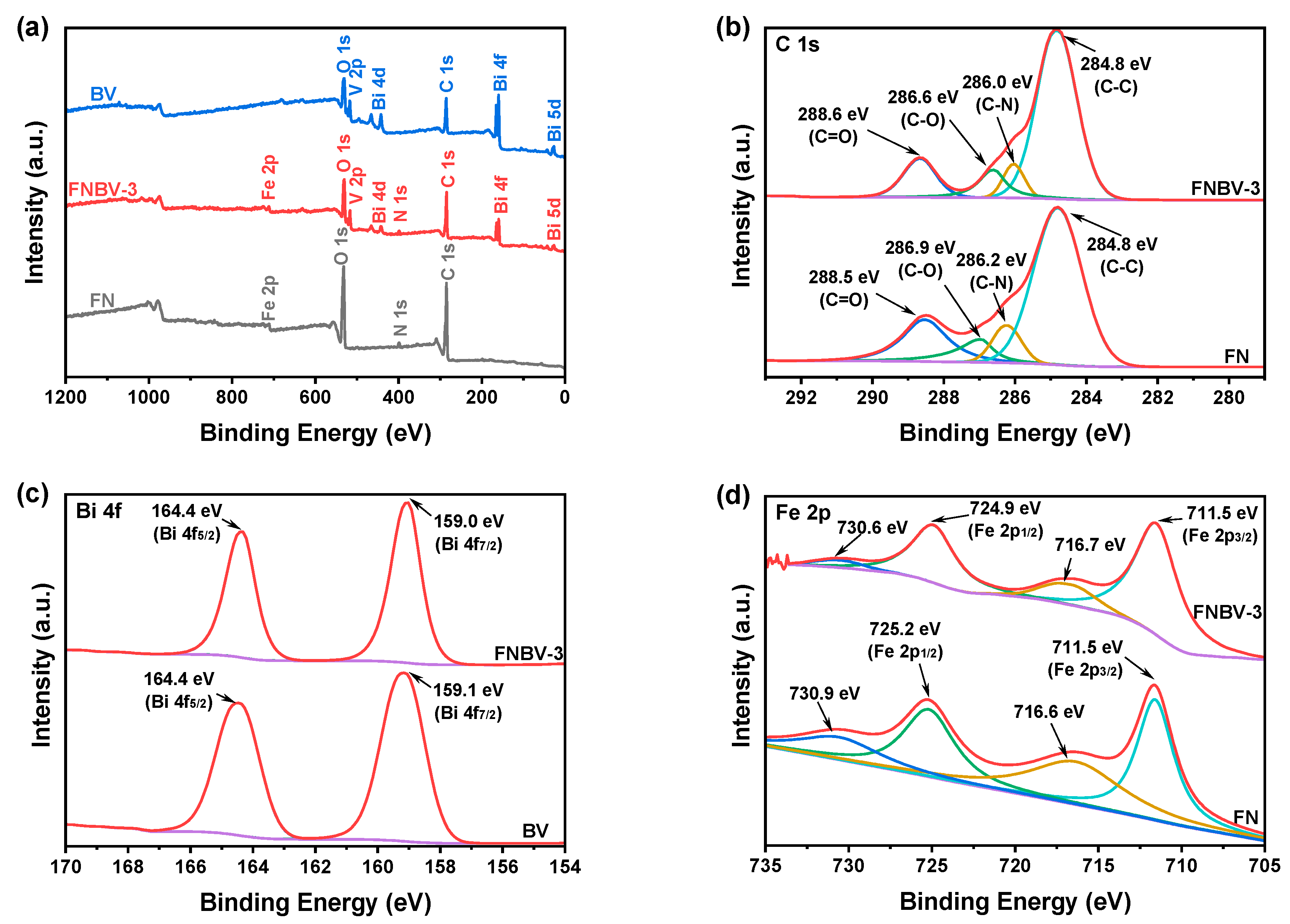
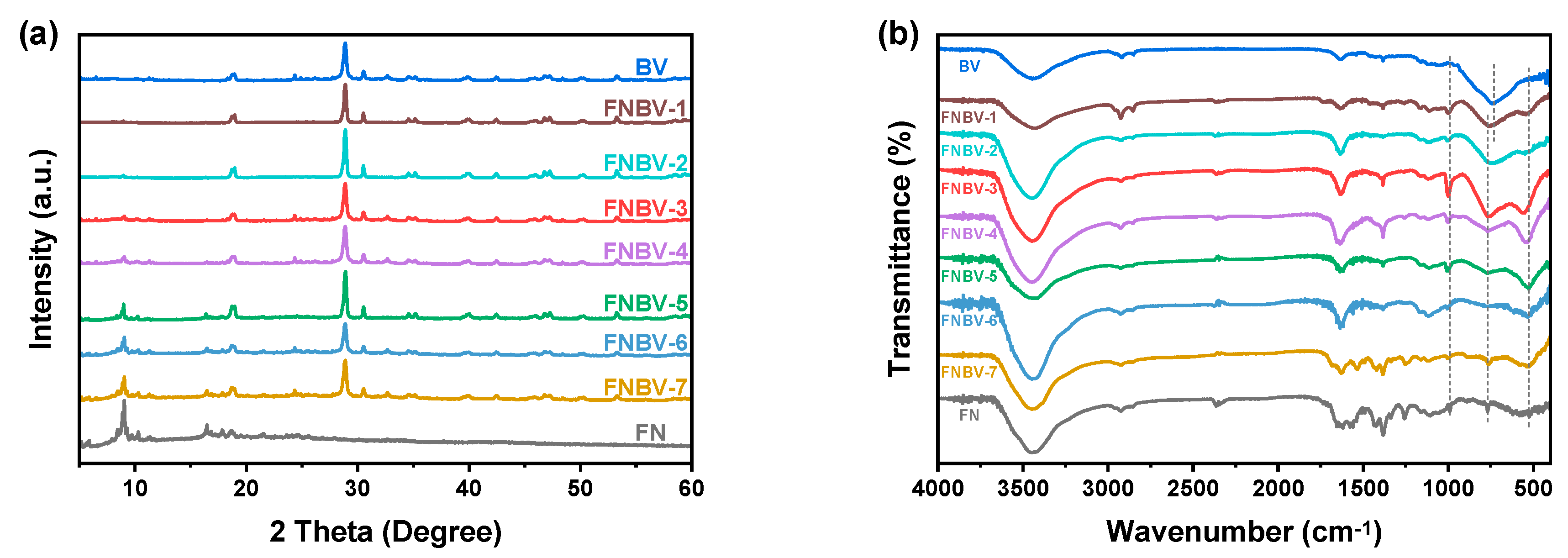
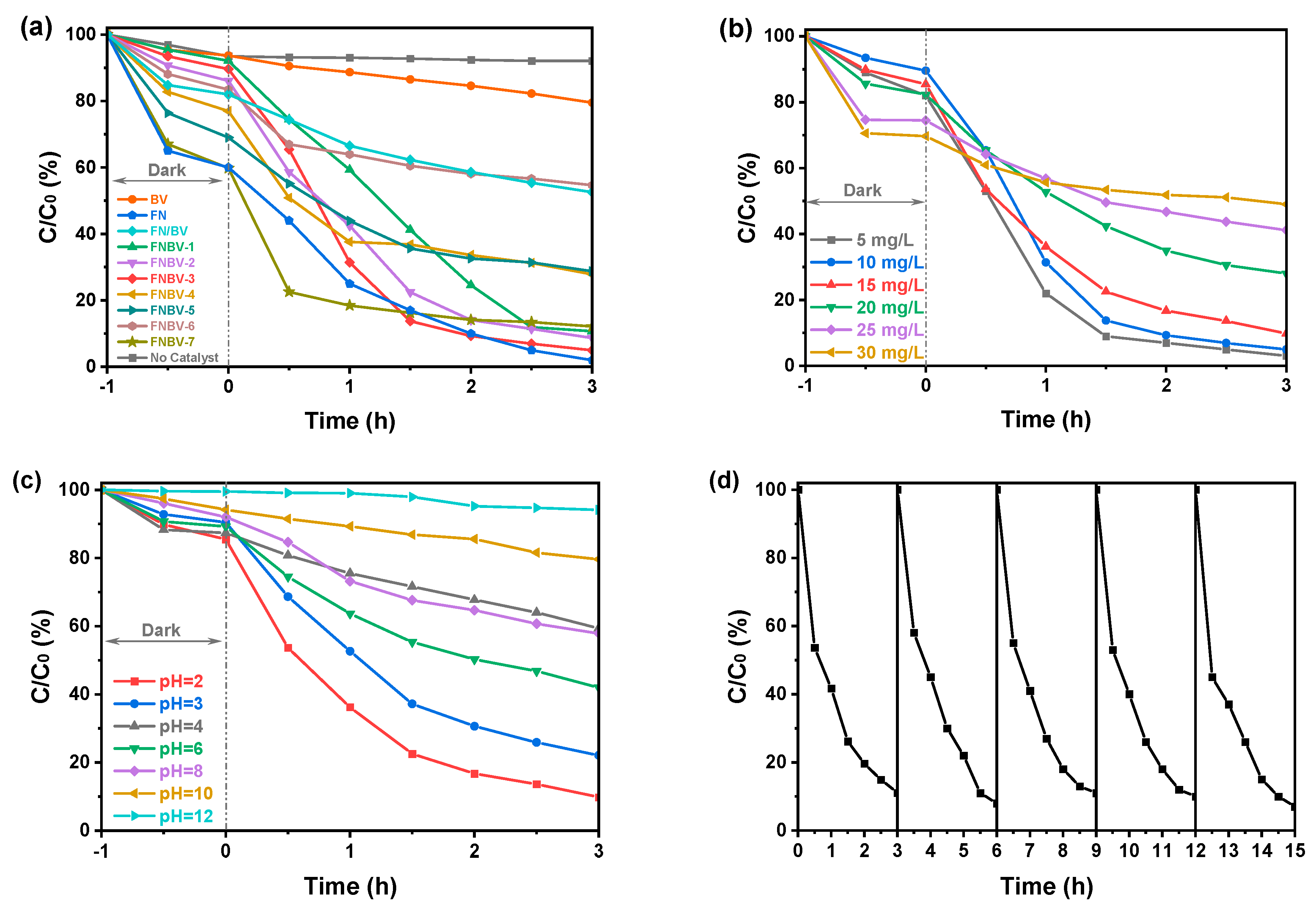
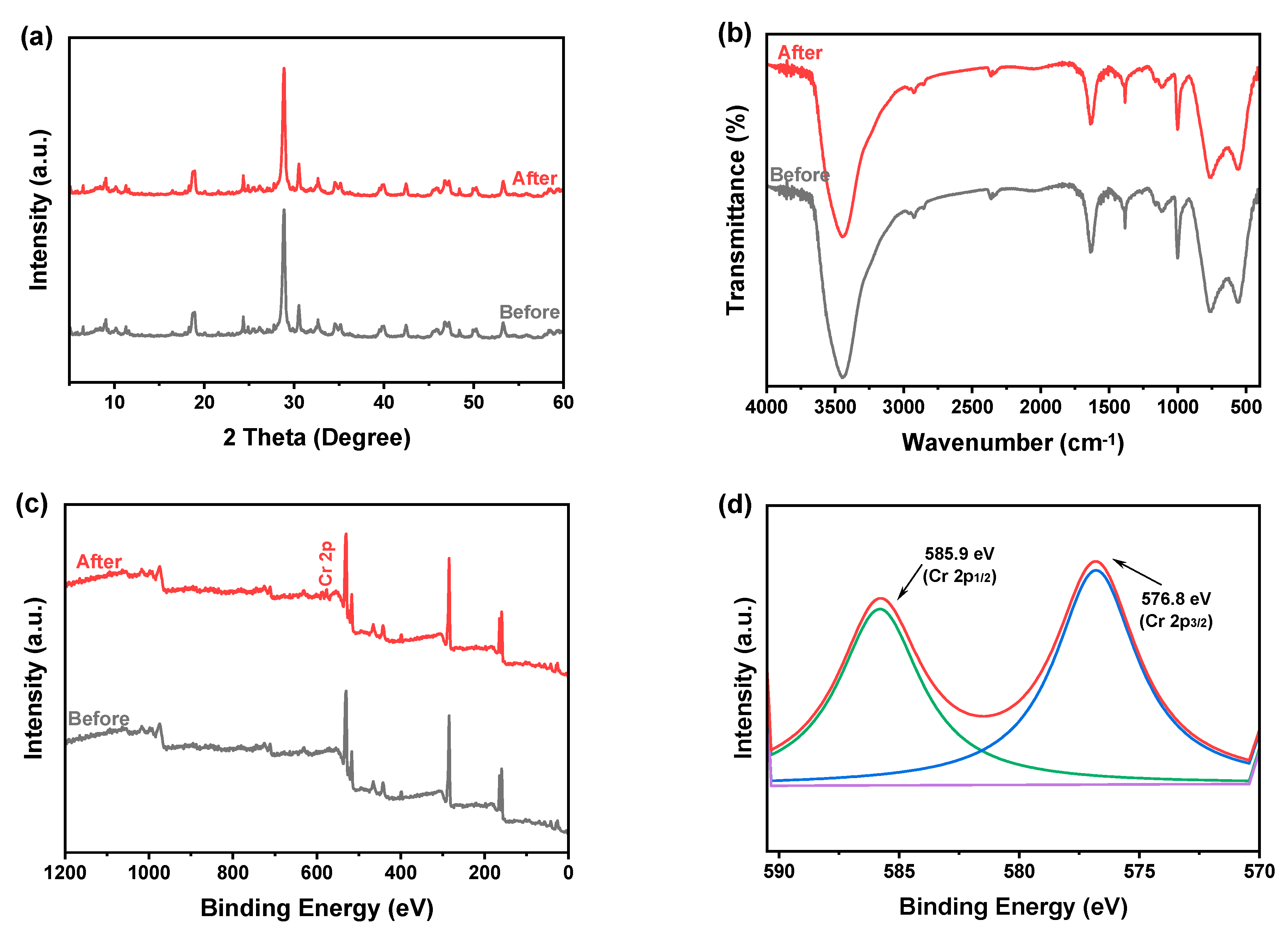
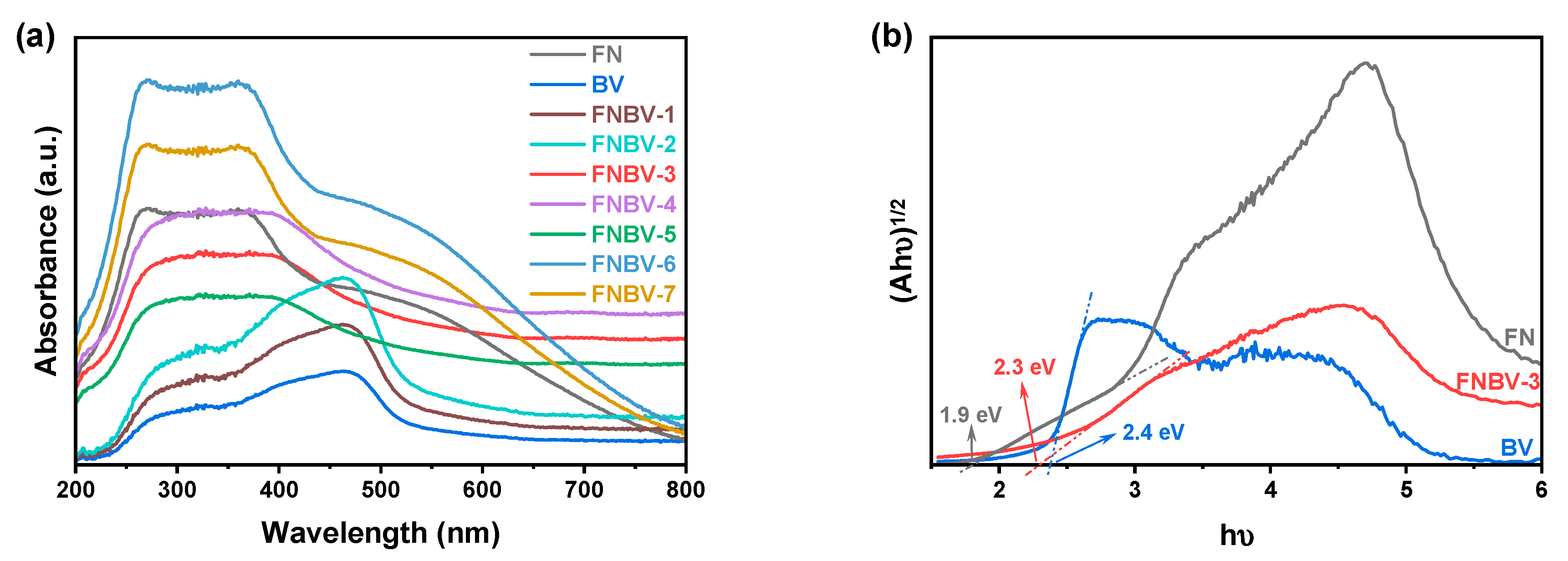


Disclaimer/Publisher’s Note: The statements, opinions and data contained in all publications are solely those of the individual author(s) and contributor(s) and not of MDPI and/or the editor(s). MDPI and/or the editor(s) disclaim responsibility for any injury to people or property resulting from any ideas, methods, instructions or products referred to in the content. |
© 2023 by the authors. Licensee MDPI, Basel, Switzerland. This article is an open access article distributed under the terms and conditions of the Creative Commons Attribution (CC BY) license (https://creativecommons.org/licenses/by/4.0/).
Share and Cite
Sun, H.; Dai, Q.; Liu, J.; Zhou, T.; Chen, M.; Cai, Z.; Zhu, X.; Fu, B. BiVO4–Deposited MIL–101–NH2 for Efficient Photocatalytic Elimination of Cr(VI). Molecules 2023, 28, 1218. https://doi.org/10.3390/molecules28031218
Sun H, Dai Q, Liu J, Zhou T, Chen M, Cai Z, Zhu X, Fu B. BiVO4–Deposited MIL–101–NH2 for Efficient Photocatalytic Elimination of Cr(VI). Molecules. 2023; 28(3):1218. https://doi.org/10.3390/molecules28031218
Chicago/Turabian StyleSun, Huiwen, Qihang Dai, Ju Liu, Tiantian Zhou, Muhua Chen, Zhengchun Cai, Xinbao Zhu, and Bo Fu. 2023. "BiVO4–Deposited MIL–101–NH2 for Efficient Photocatalytic Elimination of Cr(VI)" Molecules 28, no. 3: 1218. https://doi.org/10.3390/molecules28031218





